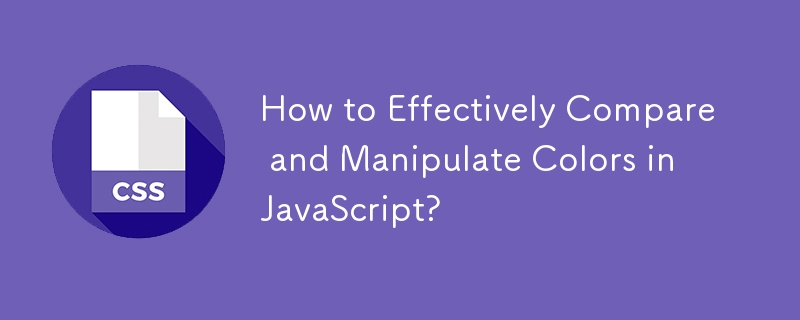How to Effectively Compare and Manipulate Colors in JavaScript?

How to Compare Colors in JavaScript: Best Practices
When writing code to compare colors in JavaScript, it's important to approach it judiciously. Here's why:
Avoid Comparing Colors Directly in Logic
While it may seem convenient to check if an element's background color matches a specific value, this approach is prone to errors and can lead to unexpected behaviors. Instead, it's best to follow these best practices:
Maintain State in JavaScript, Apply Styles with CSS
Separate the business logic from the visual representation. Use JavaScript to manage the state of elements, such as whether they are active or selected. Then, apply CSS styles based on these states. This way, the code is easier to maintain and more flexible for handling various color schemes.
Use CSS Class Names for Visual Feedback
Add CSS classes to elements to indicate their state. By doing this, JavaScript only needs to track class names, while CSS can take care of displaying the appropriate colors. This keeps the logic and styling separated, ensuring consistency and flexibility.
Example Implementation
Here's an example of how to implement this approach using jQuery:
$(".list").on("click", "li", function () {
$(this).toggleClass("active");
});.list {
width: 100%;
padding: 0;
}
.list li {
padding: 5px 10px;
list-style: none;
cursor: pointer;
}
.list li:hover {
background-color: rgba(0, 0, 0, 0.05);
}
.list li.active {
background-color: #eeeecc;
}<script src="https://ajax.googleapis.com/ajax/libs/jquery/2.1.1/jquery.min.js"></script> <ul class="list"> <li>test 1</li> <li>test 2</li> <li>test 3</li> </ul>
By following these best practices, you can effectively compare and manipulate colors in JavaScript while maintaining clean and maintainable code.
The above is the detailed content of How to Effectively Compare and Manipulate Colors in JavaScript?. For more information, please follow other related articles on the PHP Chinese website!

Hot AI Tools

Undresser.AI Undress
AI-powered app for creating realistic nude photos

AI Clothes Remover
Online AI tool for removing clothes from photos.

Undress AI Tool
Undress images for free

Clothoff.io
AI clothes remover

Video Face Swap
Swap faces in any video effortlessly with our completely free AI face swap tool!

Hot Article

Hot Tools

Notepad++7.3.1
Easy-to-use and free code editor

SublimeText3 Chinese version
Chinese version, very easy to use

Zend Studio 13.0.1
Powerful PHP integrated development environment

Dreamweaver CS6
Visual web development tools

SublimeText3 Mac version
God-level code editing software (SublimeText3)

Hot Topics
 Vue 3
Apr 02, 2025 pm 06:32 PM
Vue 3
Apr 02, 2025 pm 06:32 PM
It's out! Congrats to the Vue team for getting it done, I know it was a massive effort and a long time coming. All new docs, as well.
 Can you get valid CSS property values from the browser?
Apr 02, 2025 pm 06:17 PM
Can you get valid CSS property values from the browser?
Apr 02, 2025 pm 06:17 PM
I had someone write in with this very legit question. Lea just blogged about how you can get valid CSS properties themselves from the browser. That's like this.
 A bit on ci/cd
Apr 02, 2025 pm 06:21 PM
A bit on ci/cd
Apr 02, 2025 pm 06:21 PM
I'd say "website" fits better than "mobile app" but I like this framing from Max Lynch:
 Using Markdown and Localization in the WordPress Block Editor
Apr 02, 2025 am 04:27 AM
Using Markdown and Localization in the WordPress Block Editor
Apr 02, 2025 am 04:27 AM
If we need to show documentation to the user directly in the WordPress editor, what is the best way to do it?
 Stacked Cards with Sticky Positioning and a Dash of Sass
Apr 03, 2025 am 10:30 AM
Stacked Cards with Sticky Positioning and a Dash of Sass
Apr 03, 2025 am 10:30 AM
The other day, I spotted this particularly lovely bit from Corey Ginnivan’s website where a collection of cards stack on top of one another as you scroll.
 Comparing Browsers for Responsive Design
Apr 02, 2025 pm 06:25 PM
Comparing Browsers for Responsive Design
Apr 02, 2025 pm 06:25 PM
There are a number of these desktop apps where the goal is showing your site at different dimensions all at the same time. So you can, for example, be writing
 How to Use CSS Grid for Sticky Headers and Footers
Apr 02, 2025 pm 06:29 PM
How to Use CSS Grid for Sticky Headers and Footers
Apr 02, 2025 pm 06:29 PM
CSS Grid is a collection of properties designed to make layout easier than it’s ever been. Like anything, there's a bit of a learning curve, but Grid is
 Google Fonts Variable Fonts
Apr 09, 2025 am 10:42 AM
Google Fonts Variable Fonts
Apr 09, 2025 am 10:42 AM
I see Google Fonts rolled out a new design (Tweet). Compared to the last big redesign, this feels much more iterative. I can barely tell the difference






